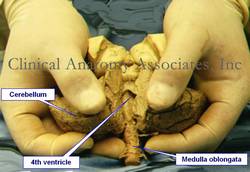|
The fourth ventricle is one of the components of the ventricular system of the brain. It is a rhomboidal-shaped cavity located between the pons of the brain stem anteriorly and the cerebellum posteriorly. The fourth ventricle is the last of the components of the ventricular system of the brain. It receives cerebrospinal fluid (CSF) from the Acqueduct of Sylvius, adds CSF produced in the choroid plexuses located in the roof of the fourth ventricle, and allows passageway of CSF to the external aspect of the brain and the subarachnoid space by way of a posteroinferior midline opening called the "foramen of Magendie". There are two small and sometimes absent or non-functional lateral openings to the fourth ventricle which also connect with the subarachnoid space called the "foramina of Luschka". These foramina are found at the end of the lateral recesses of the ventricle. |
|
| The accompanying image shows a posterior view of the brain stem and the cerebellum which has been opened in the median plane to expose the 4th ventricle. Click on the image to see a larger version. Image property of:CAA.Inc. Photography: Efrain Klein |
|
| Back to MTD Main Page | Subscribe to MTD |
